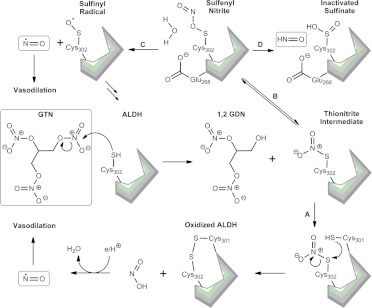Fig. 11.
Nitroglycerin interactions with ALDH. GTN is hydrolyzed by ALDH to form 1,2-glyceryl dinitrate (1,2 GDN) and a thionitrate intermediate bound to the ALDH active site cysteine (Cys302). Two proposed pathways can then be followed: in pathway A, an adjacent cysteine in the active site (Cys301) attacks the thiol of Cys302, forming a disulfide bond and releasing nitrite ion. The nitrite ion gets further metabolized to release NO, which induces vasodilation, whereas the ALDH enzyme is oxidized. In pathway B, the thionitrate intermediate rearranges to form sulfenyl nitrite, which leads to the formation of either a sulfinyl radical (C) and NO or an inactivated sulfinate (D) and HNO. [Adapted from Wenzl MV, Beretta M, Griesberger M, Russwurm M, Koesling D, Schmidt K, Mayer B, and Gorren AC (2011) Site-directed mutagenesis of aldehyde dehydrogenase-2 suggests three distinct pathways of nitroglycerin biotransformation. Mol Pharmacol 80:258–266. Copyright © 2011 American Society for Pharmacology and Experimental Therapeutics. Used with permission.]

